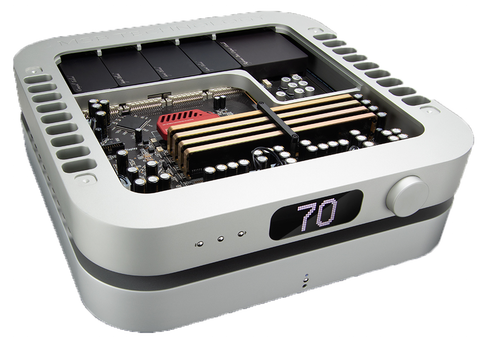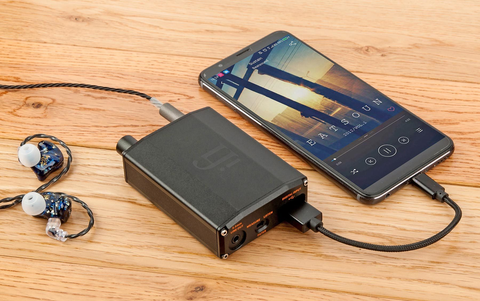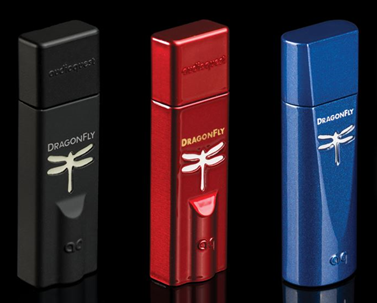Whether you’re new to audio in general or looking to put together a high-end portable or Hi-Fi system, you will likely come across the term DAC. We’ve put this guide together as a way to give you a greater understanding of what DACs are, their history, how they work and all the different types available depending on how one intends to use them.
History
DAC an acronym for digital-to-analogue converter is the term used to describe a product or chip that converts a digital signal into an analogue one so audio can be heard through speakers/headphones etc. Ultimately it reverses the process made in a studio of recording an analogue signal and digitising it for music distribution. DACs come in all shapes, sizes and types. Unknowing to most, they are in nearly every consumer product found in homes that generate sound, from TVs, mobile phones, Bluetooth speakers, CD players and many more.
The world’s first modern day DAC chip was designed and manufactured by a company called Burr-Brown Research Corporation in 1982, they were acquired by Texas instruments in 2000. Although DAC chips existed before this point, they mainly occurred in professional products for the recording industry. The development of the first 16 Bit monolithic chip by BB allowed for affordable high-quality compact disc players to come to market. This transformed the music industry and its ability to distribute and playback music via CDs which accounted for the largest revenue of music consumption by format from 1980 up until 2005 when digital downloads were introduced. Sony and Phillips were the first two companies to introduce products using this technology, although taking different approaches to implementation, they both used the same multibit DAC architecture.
The versatility and use cases of DAC chips can be seen with a couple of examples below.
With modern day mobile phone manufactures in a race to make an ever-thinner handset, many have resorted to removing the 3.5mm headphone jack completely. Although many headphones and earphones nowadays have become wireless using Bluetooth, there’s still a great deal that use the industry standard 3.5mm analogue jack. With these handsets they now supply a very small USB to 3.5mm adapter in the box, these are mass produced in the millions and cost cents to manufacture. Packed inside this tiny adapter housing is a very small DAC chip responsible for converting the digital signal from your phone into an analogue one so your headphones and earphones can playback audio.

*Image copyrighted to https://www.apple.com
By contrast and at the other end of the size and price spectrum are full size home Hi-Fi DACs that are large boxes packed with electronics that can cost over $50K.
*Image copyrighted to https://www.dcsltd.co.uk
Dedicated Hi-Fi DACs can come in many variants as those above, smaller more compact desktop versions and even portable USB equivalents. Before we move on to the next section and discuss the actual chips and variations in more detail, it’s worth noting that having a more expensive DAC chip from a specific well-known manufacturer doesn’t necessarily equate to better sound quality. A huge part of DAC design is dependent on DAC chip implementation and design of the entire board and surrounding components like the power supply, analogue filters and output stage etc. Two DACs from different manufacturers utilising the same DAC chip and model can have completely dissimilar sound signatures.
DAC Chips
There are numerous DAC chip manufacturers located all around the world, the most common and popular brands that feature in many consumer electronic products and Hi-Fi equipment include:
Wolfson (Scotland), ESS Technology (USA), Texas Instruments (USA), Asahi Kasei Microdevices AKM (Japan), Cirrus Logic (USA), Philips (Netherlands). As with most industries once a company gets to a certain size/age, acquisitions occur. As mentioned earlier in this guide Texas Instruments purchased Burr Brown, similarly Cirrus Logic acquired Wolfon in 2014. The majority of DAC chip manufacturers specialise in making DAC chips and other microelectronics components, they do not design and build finished consumer products. These chipsets are sold in bulk to equipment manufacturers who take these off the shelf modules and design a complete DAC schematic and final product in order to sell to consumers.
Each brand will have a complete range of DAC chips all at varying costs to accommodate for different applications, industries and end-user products. For example, the DAC chip used in the USB adapter module mentioned earlier in this guide will cost a fraction of the one used by a Hi-Fi specialist manufacturer for the use in the design of dedicated stand-alone reference DACs.
There are two main types of DAC chips – R2R/Multibit and Delta Sigma. The original chips by Burr Brown in the early 80s were multibit designs. Over the past 40 years as technology has evolved and advanced, there are not many companies that continue to produce multibit chips as they are costly to manufacture and implement. These have been widely replaced by delta sigma chips which are far cheaper to make. There is constant debate amongst audio aficionados as to which is better, it’s an intricate discussion that’s highly divisive, we like to think of it as two different kinds of technology that have their respective positive and negatives and it’s ultimately down to sound characteristics and a user’s preferences.
R2R (resistor to resistor) /Multibit
Most music distributed today is recorded and encoded using a pulse-code modulation (PCM) method. This approximates and records a measurement of audio that represents sound as samples of the original signal amplitude. Multibit DACs decode PCM signals with a true 16 or more, bit to bit process that preserves the original PCM samples.
This conversion of the binary signal (1s and 0s) which represents a number that determines the value of the output voltage, is done by an array of resistors, R and 2R, in ladder formation. Each set of resistors act as current dividers organised in an ascending order. An instantaneous conversion takes place where bits are translated simultaneously and does not require any oversampling. This is why true R/2R DACs are also known as Non-Oversampling (NOS) DACs.
It is a popular method used in high precision equipment but producing such converters at high levels of accuracy can get very expensive and is mainly used in military and medical applications and are most common in premium flagship audio DACs. The extremely precise resistor arrays that have to be laser-trimmed in production, means production times can be lengthy. Due to the increasing costs for the production of multibit DACs there has been a surge in popularity of a cheaper alternative that does not require the same high precision manufacturing process, these are known as Delta Sigma chips.
Delta Sigma
Delta Sigma chips (sometimes referred to as Sigma Delta) use a delta-sigma modulation method to convert high bit-count, low-frequency digital signals into lower bit-count, higher-frequency digital signals. As mentioned earlier this DAC architecture is a lot more cost efficient and has a reduced circuit complexity, resulting in it being increasingly used in modern electronics.
In order to achieve the resolution required for music reproduction, oversampling is used. One of the drawbacks to this method is that a very high level of noise is generated. To make the chip usable, sound engineers have developed many methods of sound shaping, demodulation and low pass filters that redirect this noise to frequencies above the audible range. It is for this reason that many audiophiles believe that this heavy data manipulation (a corrective process) has a drastic effect on the sound, often leaving music sounding too digital/clinical and synthetic whilst at the same time losing its overall coherence.
It’s important to remember that these views are subjective and one should always experience first hand by listening to equipment before forming your own decision. Also, there are several different chips on the market all utilising different interpolation and digital filtering algorithms along with widely varying chip implementations.
Physically and aesthetically Multibit chips and Delta Sigma chips are quite different, and are usually configured differently. DS chips are 8 channel components so usually used singularly, whilst multibit are usually aligned in a ladder formation, some examples below:
Multibit configuration
*Image copyrighted to https://www.schiit.com
Delta Sigma configuration
*Image copyrighted to https://www.schiit.com
Proprietary DACs
There are a handful of Hi-Fi brands that choose to adopt a different approach when designing and manufacturing DACs. Instead of choosing off the shelf chips front 3rd party component manufacturers, they prefer to use an FPGA (field-programmable gate array). An FPGA is a piece of silicon with an integrated circuit designed that can be configured by a customer or engineer post manufacture.
These brands start off with a blank piece of paper and write, refine and run their own code. All aspects of conversion are defined by the manufacturer from digital signal processing to filtering. This approach has some obvious benefits including:
- Full control from start to finish allowing ultimate control of the final sound and measurements
- Ability to make changes at any point even retrospectively once a product has been made and sold
- Not affected by quality issues that may become apparent from 3rd party manufacturers
The downsides to the above method are that it’s significantly more costly than buying in off-the-shelf DAC chips from semiconductor suppliers and it requires a wealth of knowledge and experienced engineers to code. Besides the fundamental performance advantages with using FPGAs many believe they can offer a superior sound and completely unique listening experience when compared to multibit and delta-sigma alternatives.
Two of the most prominent brands that use this proprietary method are dCS (UK) and Chord Electronics (UK).
DAC Types
For this next section we have chosen to focus on and give a brief overview of the different types of DACs found in the Audio/Hi-Fi industry and shed some light on how they best fit different applications and use cases.
Full Size Reference DACs
As the name would suggest, full size reference DACs are designed and built to offer the very best possible digital to analogue conversion in turn giving the highest possible quality audio reproduction. They can be large and heavy units with extremely complex internal designs that are manufactured with no expenses spared in order to extract every last detail within a recording as faithfully as possible.
There are multiple variations with some having external power supplies, built in preamps, and more recently streaming modules. One thing common amongst all DACs is they must have digital inputs and an analogue output. Digital inputs can include USB, Optical, Coax, HDMI and RJ45, these are responsible for passing the digital signal from your source (network streamer or computer) directly to the DAC for the conversion to take place. This signal is then fed to a pre amplifier (if not integrated) via the analogue output which boosts this input signal to match the line level signal ready to be amplified and played back through speakers.
Full size reference DACs can vary greatly in price, but as they are designed using the best components available, they can cost anywhere from $1000 all the way up to a mouth-watering $140,000.
*Image copyrighted to https://www.msbtechnology.com
Desktop compact DACs
The technological boom of the last 30 years has led to most families having 1 or more personal computers in their homes. This along with the rise in digital audio and music streaming services means many people are looking for compact desktop DACs to use at a desk to convert digital audio from their computers, laptops and tablets into sound.
As always these come in a range of sizes, offering different specifications etc, and many include a dedicated headphone amplifier.
Many of the devices which have built in headphone amps tend to have a wide range of headphone outputs to support headphones and earphones of all types, with some also including balanced designs. Common connections found on these units are Balanced (2.5mm, 4.4mm, 4 pin XLR, dual 3 pin XLR) Unbalanced (3.5mm, 6.35mm).
There are a number of brands which specialise in this type of product, and as its type has become more popular there’s been an increased number of traditional Hi-Fi brands and headphone manufacturers moving in to this space and offering a desktop style compact DAC/amp, some of the more popular brands are: iFi, Burson Audio, Schiit, SPL, Violectric, Sennheiser and many more. 
*Image copyrighted to https://www.bursonaudio.com
Portable DACs
The acceleration in sales for portable headphones and IEMs over the past 8-10 years has meant a new product category emerging in the form of small DAC/amp devices for use with smartphones and other Digital Audio Player (DAPs).
Normally the size of a smartphone or smaller, they are intended to take the digital signal from a mobile device, use a more advanced outboard DAC and powerful amplification stage giving the user the best possible audio quality whilst listening to music on the go.
Some of the more recent designs are so compact, powerful and excel in sound performance that many use these as transportable DAC/amps for use whilst commuting and then on a desk when arriving at work or home in order to boost PC audio. Being battery powered they offer a fantastically clean power source without the usual noise found from AC wall outlets that power mains devices. Increasingly larger batteries now mean you can have 12 hours of playback time for all day use.
Two of the most popular brands making portable DACs are iFi and Fiio.
*Image copyrighted to https://ifi-audio.com
USB DACs
Those looking for the smallest and most compact form of DAC should consider USB DACs. These are usually no bigger than a standard size USB memory stick used in computing. Housed within these tiny casings are leading edge DACs and surprisingly powerful amplifiers.
Due to their weight and size they are great to use with mobile phones and small enough to use in-line with most earphones and headphones, making them the most discrete solution for high-resolution audio on the go. They also do a good job of powering high-end headphones so using it within the USB port of your computer or laptop is also an option.
The most well known and types of USB DACs are the Dragonfly range by Audioquest.
*Image copyrighted to https://audioquest.com
We hope this guide has been helpful in giving some insights into the world of DACs, allowing you to fully appreciate their complexities and better understand the wide variety of forms they can come in.
One thing is for sure, however you plan to convert digital audio to analogue and listen to music there’s a solution out there to cater for it.
With technology progressing rapidly and size of components and hardware getting smaller, the performance one can get from even the most portable of devices can quite often offer world class sound capable of holding its own for use within a home audio system.




